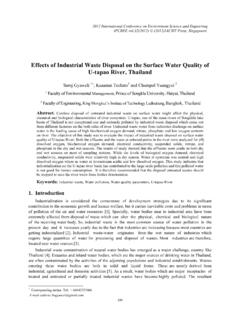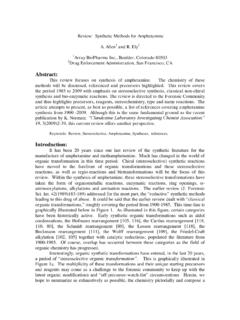Transcription of Gas Sweetening Units Risk Assessment Using HAZOP …
1 2011 International Conference on Biology, Environment and Chemistry IPCBEE (2011) (2011)IACSIT Press, Singapoore Gas Sweetening Units Risk Assessment Using HAZOP Procedure Mahdi Goharrokhi1,+ , Fateme Farahmand2, Maryam Otadi3. 1. Department of Chemical Engineering, Islamic Azad University, South Tehran Branch, Tehran, Iran 2. Department of Chemical Engineering, Islamic Azad University, Shahrood Branch, Tehran, Iran 3. Department of Chemical Engineering, Islamic Azad University, Central Tehran Branch, Tehran, Iran. Abstract. HAZOP Study (Hazard and operability study) is a well known Hazard analysis tool used for process safety management and HSE risk Assessment of plans and facilities.
2 The Hazard and Operability ( HAZOP ) study is a widely used formal technique for examining potential safety and operational problems associated with a system. In this work, hazards of Gas Sweetening Units were assessed by Using HAZOP . procedure. All of the deviations were considered by HAZOP team and the recommendations were suggested to reduce the likelihood of consequences that mostly were related to the environmental risk. Keywords: Safety; Hazard Identification; Hazard and Operability Study; Gas Sweetening unit , Risk 1. Introduction HAZOP is the method recommended for identifying hazards and problems which prevent efficient operation of a processing plant.
3 The HAZOP team focuses on specific portions of the process called "nodes". Generally these are identified from the P&ID of the process before the study begins. A process parameter is identified and an intention is created the node under consideration. Then a series of Guidewords is combined with the parameter to create a deviation. The team considerer about causes of deviation beginning with the consequences, safeguard and recommendation. The result of HAZOP depend more upon the experience and attitudes of the participants and on the leadership style adopted, than on the procedures themselves [4-6]. 2. Hazard Identification The Hazard identification process should consider all operating modes of the facilities and all activities that are expected to occur.
4 It should also consider human and system issues as well as engineering issues. The hazard identification process should be ongoing and dynamic. It should not just be carried out during development of the safety case but also in a range of There are the number of hazard identification and hazard analysis method available, which can either be qualitative or quantitative in nature. Qualitative method including Checklist, What-If Review, Hazard an Operability Review ( HAZOP ), Preliminary Hazard Analysis, and Failure Mode Analysis (FMA). Quantitative method includes Event Trees, Failure and Effects Analysis (FMEA) [3].
5 HAZOP analyses and FMEA involve many people and tend to be more expensive but, you can have greater confidence in the exhaustiveness of HAZOP and FMEA techniques their rigorous approach helps ensure completeness [1, 8]. 3. Hazard Evaluation of Gas Sweetening Units Natural Gas is supplied to this plant. The CO2 is removed from the process gas stream in two-stage CO2. Absorber. The absorber overhead gas enters KO drum, where any entrained solution is separated out. Semi- lean solution enters the top of the bulk section of the bulk of the CO2 removal takes place. Lean solution 1. Tel.: +989121045125; fax: +982177616707.
6 E-mail address: 334. enters the top of the lean section of the absorber where the final CO2 removal takes place. The rich solution from the absorber bottom passes through the Hydraulic Turbine for power recovery. The desorbed gases leave via the vapour outlet and passes into the fuel gas system. The solution enters the CO2 Stripper. The rich solution from the HP Flash Vessel enters the LP flash section, which uses a mixture of steam and stripping gas generated in the stripping section below to remove the chemically bonded CO2. The rest of the carbon dioxide is released to the atmosphere on pressure control. The lean solution is cooled before being sent to the top section of the absorber by the Lean Solution Pumps.
7 4. Results and Discussion Entrance streams to Absorber tower are NG and MDA. CO2 exit from overhead stream and rich solution exit from bottom stream. The most important deviations discussed in this part. If entrance gas to this absorber is cut, solvent will leave this tower without doing absorption. If No Flow is occurred in MDA. stream by any reason, Natural Gas will enter to this line and NG enters to environment. H2 is existed in NG. and explosion may be occurred. Inlet NG stream should be cut rapidly when MDA stream doesn't have any flow rate. To considerer a XV or shut off valve in this line for preventing to enter gas to this line.
8 This shut of valve should be act automatically or manually. The position of this valve is important. Operator should be had able close it rapidly. This shut of valve had been shut down plant by sending a signal. 5. REFERENCES. [1] Arthur Kohl and Richard Nielsen, Gas purification, 5th ed, Gulf Publishing Company, 1997. [2] P. Dennis and Nolan, Application of HAZOP and What-If safety reviews to the petroleum, petrochemical &. chemical industries, New Jersey, USA, 1994. [3] Arendt and Lorenzo, Evaluating Process Safety in the Chemical Industry, American Institute of Chemical Engineers, New York, 2000. [4] Keletz, HAZOP and Hazan, 4th ed.
9 , Taylor and Francis, 1999. [5] Jordi Dunjo, Vasilis Fthenakis, Juan A. Vilchez and Josep Arnaldos, Hazard and operability ( HAZOP ) analysis, A. literature review, Journal of Hazardous Materials, Vol. 173, 2010, pp. 19-32. [6] F. Mushtaq and Chung, A systematic HAZOP procedure for batch processes, and its application to pipeless plants, Journal of Loss Prevention in the Process Industries, Vol. 13, 2000, pp. 41-48. [7] Nigel Hyatt, Guidelines for Process Hazards Analysis, Hazards Identification & Risk Analysis, Dyadem Press, Canada, 2003. [8] David Macdonald, Practical Hazops Trips and Alarms, IDC Technologies, Elsevier, 2004.
10 335. Figure 1: P&ID of Gas Sweetening section 336. Node:. CO2 Absorber System Drawings: Type: Equipment ID: Design Conditions/Parameters: Deviation: 1. No Flow Risk Matrix Causes Consequences Safeguards Recommendations Responsibility Status S L RR. 1. No gas feed to 1. Lower pressure in T- 1 4 4. T-2001 2001. 2. Blocked outlet 1. Pressure increase in 2 4 8 1. PIC-2024 , 1. RBI and FFS. (MOV-3001 or XV- T-2001 and upstream PSV-2005, PSVs study should be 3001 by any equipment and PICs for done reason fully upstream closed) equipment 3. FV-2004A fails 1. Loss of absorbent for 2 3 6 1. FALL-2004B. closed or low set T-2001 results in CO2 closes MOV-3001.











